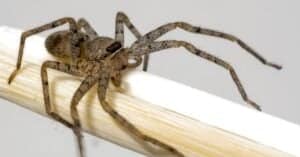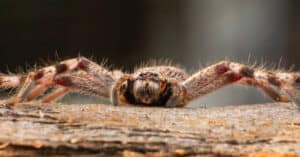What is that giant yellow spider in your garden? If you tend to your tomatoes and find a giant yellow spider, how can you tell if it is a garden spider, banana spider or the new Joro spider? All three spiders look similar but there are some key differences that can help you tell them apart. Let’s take a look at the giant yellow spiders in your garden!
What are other names for these spiders?
Just so we are all on the same page, let’s look at other names for these spiders:
- Joro spider (Trichonephila clavata): East Asian Joros
- Yellow Garden Spider (Agriope aurantia): sometimes called Writing spider, Black and Yellow Argiope
- Banana spider (Nephila clavipes): Golden Orb Weaver, Golden Silk Orb Weaver, Giant Banana spiders
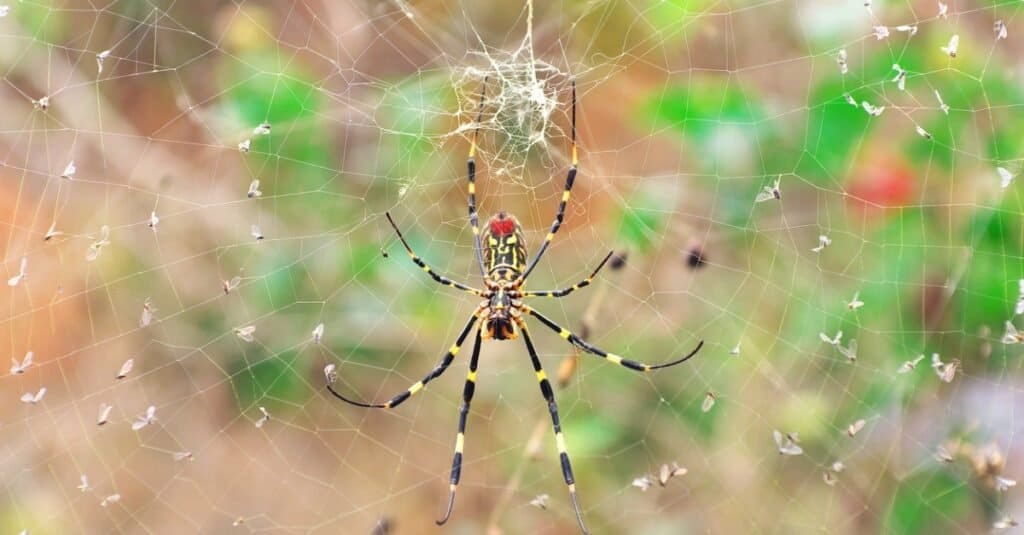
Joro spiders are a new spider to the United States. It is a spider that is native to Japan.
©bozmp/Shutterstock.com
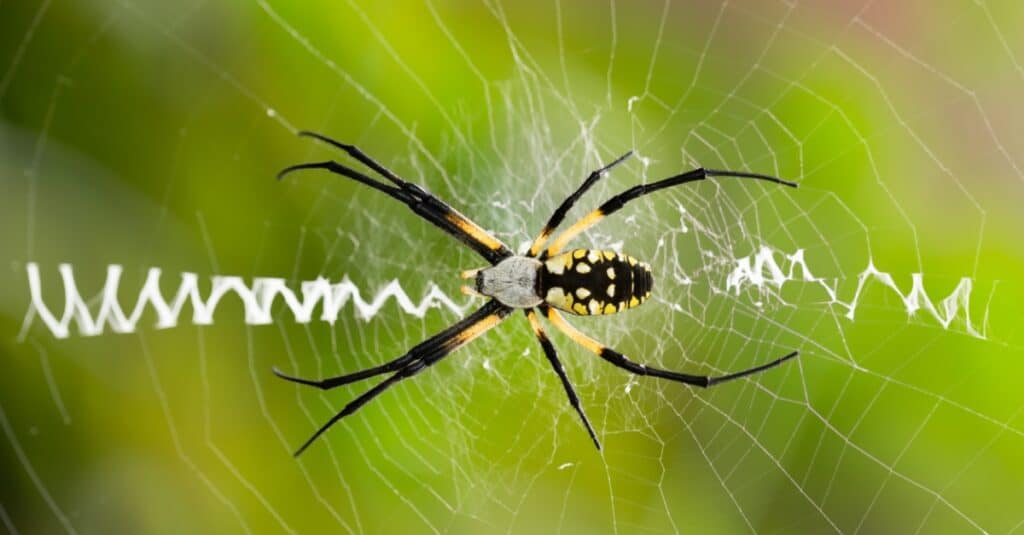
Yellow Garden Spiders (or Writing spiders) spin a zig-zag design in their webs.
©iStock.com/DianaLynne
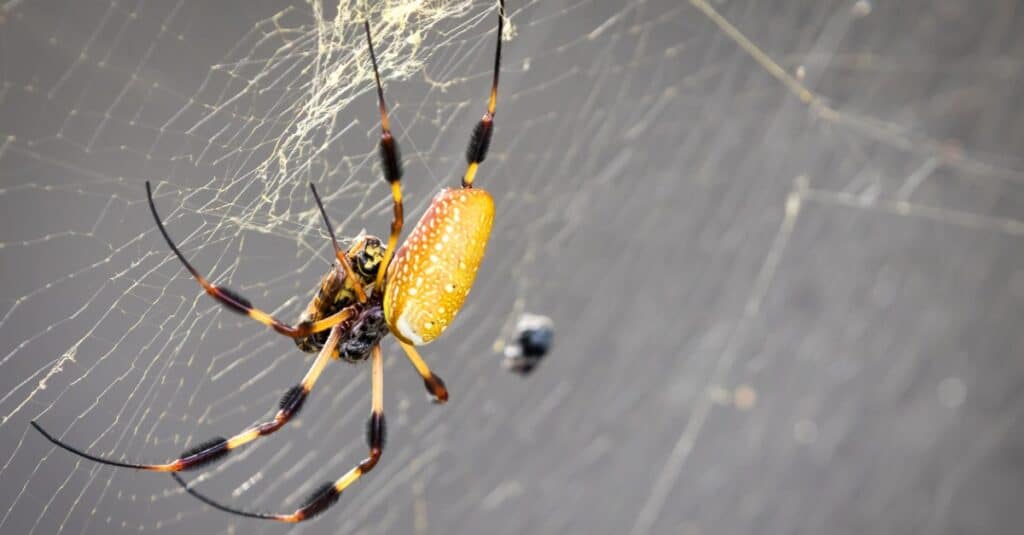
Banana spiders are also called Golden Orb Weavers because their webs are made of gold-colored silk.
©iStock.com/NikonShutterman
Where do yellow spiders spiders live?
The Joro spider is not native to the United States and has just recently (2014) been introduced to the States. So unless you are in Georgia or South Carolina you can rule out the Joro. However, new research out of the University of Georgia suggests that Joro spiders may be moving north along the coast. This spring it is likely that they have made their way into North Carolina and maybe even further north. The study found that Joro spiders are able to withstand colder temperatures better than the Yellow Garden spider so they might be fine in cooler climates. Where do these spiders live now?
- Joro spiders: Georgia, South Carolina (native to Japan and East Asia)
- Yellow garden spiders: throughout the United States (except Alaska), Southern Canada, Mexico and Central America
- Banana spiders: southeastern United States, Africa, Asia and Australia
How big are yellow garden, Joro, and banana spiders?
All three of these spiders are considered big, some say giant even. The smallest is the yellow garden spider with the Joro next and the largest of the three is the banana spider. Note: these are the measurements of the adult females; the males are significantly smaller in all three species.
- Yellow Garden: bodies are .75-1 inch, leg span up to 3 inches
- Joro: bodies up to an inch, leg span 3-4 inches
- Banana: bodies 1.5-2inches, leg span 4-5 inches
What does each yellow spider look like?
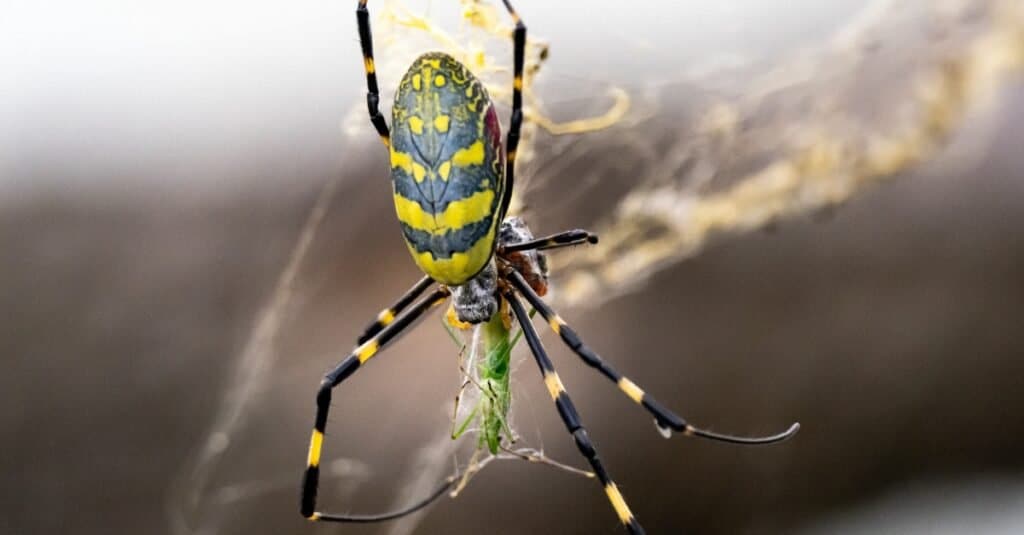
Joro spiders have exceptionally long legs and large abdomens.
©iStock.com/David Hansche
Depending on the time of year these spiders change quite a bit as they grow from hatchlings to adults. But if we are comparing adult females there are some distinct differences. The males of all three species are not only significantly smaller, but they are also mostly brown with very little color.
- Joro: Their bodies are cylindrical with yellow and black markings mixed with some red. Their undersides have a red mark as well. Their long skinny legs are striped, with alternating blue and yellow bands.
- Yellow garden: The bodies are an elongated oval shape (wider than the Joro) with a smaller gray head. They are black with yellow markings on their sides and backs. Their legs are reddish-brown near the body and black at the ends.
- Banana: Their bodies are longer than the Joro and yellow garden spider, but look similar with the yellow, black and some red markings. Their legs are also striped like the Joro but have tufts of hair at the joints.
Comparing the webs of Joro, yellow, and banana spiders
One of the easiest ways to tell the difference between the Joro and yellow garden spiders is their webs. But the webs of the Joro and banana spider are quite similar.
- Joro webs: Joros spin intricate spherical webs that are golden in color. Their webs can reach 10 feet across!
- Yellow Garden webs: The yellow garden webs are more like traditional webs, being one layer with tighter spacing near the center and then spreading out. The unique part about this spider’s web is the distinct zig-zag pattern that radiates out from the center. This pattern gives the Yellow garden its nickname as the writing spider”.
- Banana webs: The webs of the Banana spider are spun with golden colored silk and are also spherical. Their webs are large, reaching 3 feet wide or more.
Do yellow spiders all “balloon” – or fly – to get around?
Ballooning is the technique used by some spiders to relocate, with baby and juvenile spiders sometimes hatching and then forming balloon-like parachutes with their webs. They float on the air’s current to disperse throughout the area. Do these spiders use ballooning to get around?
- Joro spiders: Yes, they balloon to get around. Joro spiders could use this technique to gradually travel up the East Coast.
- Yellow Garden Spiders: Balloon to get around. They are already dispersed throughout the United States and Southern Canada which is the edge of their northern habitat.
- Banana spiders: Yes, they balloon to get around. They have been in the United States for 150 years but have not traveled up the East Coast. In the US they are only located in the southeastern states.
Are yellow spiders harmful to humans?
- Joro spiders are not harmful to humans. Their fangs are too small to penetrate the skin of a human. Pets are safe too for the same reason. They are venomous but their venom is not considered toxic to humans.
- Yellow Garden spiders are not harmful to humans. They can bite but only if threatened or surprised. Its bite is reported to be a little less painful than a bee sting. Most spiders are venomous to some degree, but the venom of the yellow garden does not have a toxic effect on humans.
- Banana spiders are not harmful to humans. Bites are rare but if you are bit it results in only mild soreness and maybe some swelling. Like most spiders, Banana spiders are venomous too. They wrap their prey (like a juicy wasp) in silk and then inject them with venom, debilitating them. Then they suck out the nutrients. Their venom is not toxic to humans.
Are these giant yellow spiders harmful to your garden?
Although it may be startling to see a giant yellow spider in your garden they are actually quite beneficial. Some call them “Natural Pesticide” because they kill and eat many of the pests that are in your garden. They kill aphids, beetles, wasps, flies, and mosquitoes. If they do spread a giant web in an area you need to access or frequently walkthrough you can gently move their web with a broom. Sharing your backyard with these spiders may also make your backyard BBQ’s more enjoyable with fewer mosquitoes around!
The photo featured at the top of this post is © Kelly vanDellen/Shutterstock.com
Thank you for reading! Have some feedback for us? Contact the AZ Animals editorial team.




